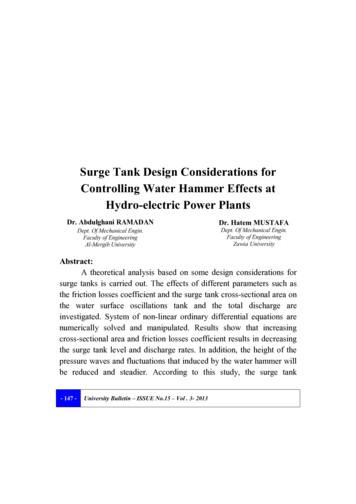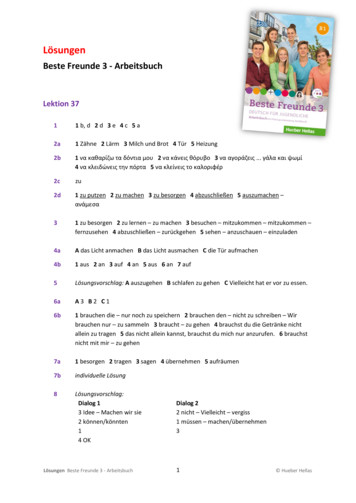Sizing Pressure Tank Final - Water Systems Council
wellcare information for you aboutSizing a Pressure TankThe functions of a pressure tank are to:(1) protect and prolong the life of the pump by preventing rapid cycling of the pumpmotor;(2) provide water under pressure for delivery between pump cycles; and(3) provide additional water storage under pressure to assist the pump in meetingthe total demands of a system if the pump or well is incapable of supplyingthe required capacity.Selecting a Pressure TankWhen selecting a pressure tank, certain information must be known:(1) system demand;(2) pump capacity; and(3) well capacity.The system demand is a function of water usage and location, expressed as gallon(s) perminute (gpm) and pound(s) per square inch gauge (psig), respectively. Usage or flow (gpm)can be determined using one of several methods (refer to Table IV.1.1 for typical demands):a) The fixture method determines the system demand by totaling the number offixtures in the home, including outside hose bibs, and multiplying this number by 1gallon per minute (gpm). For example, 10 fixtures x 1 gpm 10 gpm.b) The peak demand method determines system demand considering that morethan one fixture will be in use under peak demand. The number of fixtures beingused at the same time is determined and multiplied by 3 gpm. For example, 4fixtures x 3 gpm 12 gpm.c) An alternate method determines system demand by calculating the number ofbathrooms (half baths are considered as 1) and multiplying by 4 gpm. For a homewith 2 ½ bathrooms, multiply 3 x 4 gpm 12 gpm.Use the largest system demand determined by the above methods. For determiningsystem demand for water systems supplying farms, and public or commercial buildingssuch as schools or motels, see our Water Systems Handbook.wellcare information on Sizing a Pressure TankJune 2014January 2007
wellcare information on Sizing a Pressure TankPage 2The pump capacity should be selected according to the system demand. If a pump exists,the capacity must be determined.The well capacity should be documented when the well has been declared ready for useand will often be referred to in gallons per hour (gph). If the well capacity is unknown, itshould be determined by measuring the well water level. The water level must be loweredvia pumping, measured, then allowed to recover to the static water level. A record of thetime required to return to static water level along with the well pipe size can be used tocalculate the well capacity (recovery). An alternate method of determining if the well capacityis sufficient for system demand is to draw water from the well at or above the peak demandand determine if the well can sustain the peak demand flow.A typical water system will have adequate well capacity and pump capacity to meet orexceed the system demand. The system will commonly function using a differentialpressure switch to control the system pressure at or above the minimum required systempressure.Total Tank VolumeSelecting the pressure tank total volume for typical systems will consider the pump capacity.Total tank volume is not a measure of tank acceptance volume, which is typically consideredto be available water volume or tank drawdown. Total tank volume is a measure of the totaltank size required to provide the required available water. The total tank volume will varydepending on tank type.WELL WATER - NATURALLY BETTER
wellcare information on Sizing a Pressure TankPage 3a) Referring to Table IV.1.2, select the pump capacity, tank type and pressureswitch settings to determine the total tank volume.b) When it is desired to have a pressure switch setting different from thoseincluded in the table, the total tank volume can be determined as follows:Total tank volume Minimum Drawdown (from Table VI.1.2)Acceptance Factor(Acceptance Factor is the factor of the total tank volume that will provideavailable water).Acceptance Factor is calculated using the pressure tank precharge pressure (2 psigbelow the pump cut-in pressure). The pressure tank will operate between thepressures set by the pressure switch. The tank precharge pressure should be set at2 psig below the low pressure cut-in to prevent a noticeable drop in pressure at thefixture.Acceptance Factor 1 –((P1 cut-in – 2) 14.7)(P2 cut-out 14.7)WELL WATER - NATURALLY BETTER
wellcare information on Sizing a Pressure TankPage 4When the Well or Pump Cannot Meet Peak DemandIn cases where the well cannot meet the peak system demand, additional pump protectionmay be required in the form of floats or power monitors. For more information on lowproducing wells, reference the Water Systems Handbook.In cases where the pump cannot meet the peak system demand, a supplementaldrawdown may be obtained from the pressure tank. (See figure above). Supplementaldrawdown can be added to the pressure tank by adjusting the tank and system pressuresin order to supplement the system during times of peak demand. When the pump can meetthe system demand, it will operate between the pressure switch settings. When the pumpcannot meet the system demand, the pressure will drop below the cut-in pressure. Thesupplemental drawdown is supplied by the tank at a pressure between the tank prechargeand the cut-in pressure.The supplemental drawdown required is determined from peak demand:Supplemental Drawdown (Gallons) [Peak Demand (gpm) – Pump Capacity (gpm)] * [Peak Demand Time (minutes)]The total required drawdown is determined by referring to Table IV.1.2 to obtain theminimum drawdown:Total Required Drawdown (Gallons) [Minimal Drawdown Supplemental Drawdown]Total Tank Volume Total Drawdown / Acceptance Factorwhere theAcceptance Factor 1 –(P1 pressure tank precharge 14.7)(P2 cut-out 14.7)Consult the manufacturer for additional assistance in determining proper tank sizing andpressure settings.WELL WATER - NATURALLY BETTER
wellcare information on Sizing a Pressure TankPage 5For more information on sizing a pressure tank see our Water Systems Handbook.FOR MORE INFORMATION to help you maintain your well and protect your water supplywellcare is a program of the Water Systems Council (WSC). WSC isthe only national organization solely focused on protecting the health andwater supply of the 43 million people nationwide who depend onhousehold wells for their water supply.This publication is one in a series of wellcare information sheets. There are more than 90information sheets available FREE at www.watersystemscouncil.org.Well owners and others with questions about wells or groundwater can also contact the FREEwellcare Hotline at 1-888-395-1033 or visit www.wellcarehotline.org.JOIN THE WELLCARE WELL OWNERS NETWORK!By joining the FREE wellcare Well Owners Network, you will receive regular information onhow to maintain your well and protect your well water.Contact us at 1-888-395-1033 or visit www.watersystemscouncil.org orwww.wellcarehotline.org.WELL WATER - NATURALLY BETTER
Acceptance Factor is calculated using the pressure tank precharge pressure (2 psig below the pump cut-in pressure). The pressure tank will oper ate between the pressures set by the pressure switch. The tank precharge pressure should be set at 2 psig below the low pressure cut -in to prevent a noticeable drop in pressure at the fixture.
3- Differential surge tank: an orifice tank having a riser is called differential tank. 4- One- way surge tank: in a one way surge tank the liquid flows from the tank into the pipeline only when the pressure in the pipeline drops below the liquid level in the surge tank. 5- Closed surge tank: if the top of the tank is closed and there is
2.4 Other types of control valves 40 2.5 Control valve selection summary 42 2.6 Summary 46 3 Valve Sizing for Liquid Flow 47 3.1 Principles of the full sizing equation 48 3.2 Formulae for sizing control valves for Liquids 51 3.3 Practical example of Cv sizing calculation 52 3.4 Summary 54 4 Valve Sizing for Gas and Vapor Flow 55
Battery Sizing Example 4. Sizing with Software 5. Battery Charger Sizing Saft Battery 2 Sizing. The Art and Science of Battery Sizing Saft Battery . 2-8 hr. battery backup normal Time (hh:mm:ss) Current (A) Paralleling Switchgear 8 120V to 600V (typical) DC bus 24, 48 or 125Vdc
Pressure in expansion tank incorrect Check tank pressure and adjust (see instructions) Expansion tank not large enough Fit larger tank . Hot water appears in cold water line : Non-return valve in inlet line to calorifier absent or ineffective Check presence/condition of non-return valve . Schrader valve leaks : Expansion tank membrane split
prevent tank uplifting, the following are minimum requirements for different types of common tank supports and surfaces upon which the tank shall be placed. Tank Supports – Tank supports shall be either (a) types that are included under the tank Listing (steel saddles welded to tank), or (b) 1.25" diameter
Fin – Input flow rate of the tank F out – Output flow rate of the tank H - Total height of the conical tank. R - Top radius of the conical tank h - Nominal level of the tank r - Radius at nominal level Fig3. Mathematical modeling of a conical tank The area of the conical tank is given by (3.1) R
tank, this work was designed the refill sauce storage tank connection to the normal sauce storage tank to control level sauce in tank. m Fig.7. two liquid storage tank systems The purpose of this study is to control level in normal sauce tank. The apparatus, shows in Fig.7, consisting of normal sauce tank and one more refill sauce tank.
2 9 1 besorgen 2 übernehmen 3 tragen 4 arbeiten 5 haben 10 A Fußball B geht um das Wetter. C Es geht um ein neues Auto. D Es geht um den Oscar für den besten Film͙ 11 1 informiert 2 verabreden 3 machen 4 fotografiert 5 schreiben 12 1 Choreografie 2 Stadtteil 3 Artikel 4 Fastfood-Restaurant 5 soziale Medien 6 Autofahrer 13 2 Sie fährt Motorrad. 3 Er spielt Fußball. 4 Sie tanzt Tango. 5 Er .























